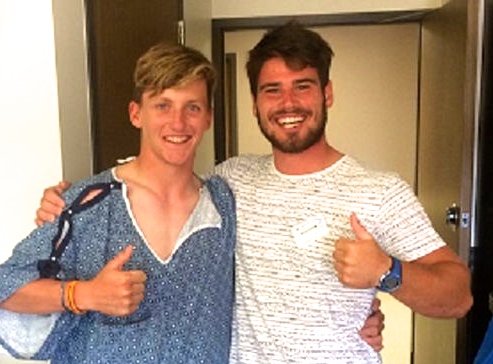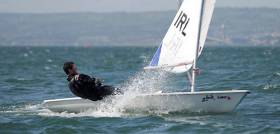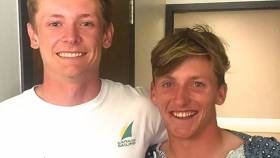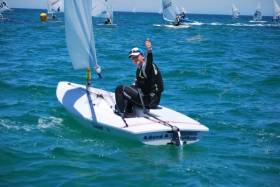Displaying items by tag: Johnny Durcan
Royal Cork 49er Pair Breeze into the Lead of Irish Olympic Trial at Lanzarote World Championships
On the first day of the Irish Olympic 49er trial, Royal Cork Yacht Club's Seafra Guilfoyle and Johnny Durcan had a better day than rivals Robert Dickson (Howth Yacht Club) and Sean Waddilove (Skerries Sailing Club) for the Paris 2024 berth later this summer.
Thanks to a second place in the opening race followed up with two 14th places, at one stage the Cork Harbour pair were on course for a top three finish in the third race except the duo had a capsize from which they quickly recovered to be 17th overall.
Racing for the second flight of boats in this initial qualification round was delayed for almost two hours as the race course was shifted to find better wind conditions. This group included Ireland's second pairing of Dickson and Waddilove who had a fifth as their best result of the day along with a tenth and a 21st. to lie 21st overall.
 Robert Dickson (Howth Yacht Club) and Sean Waddilove (Skerries Sailing Club) competing in Lanzarote Photo: 49er class
Robert Dickson (Howth Yacht Club) and Sean Waddilove (Skerries Sailing Club) competing in Lanzarote Photo: 49er class
The Dublin pair are part of Irish Sailing's Senior Squad and qualified for Ireland in November for the men's skiff event for the Paris 2024 Olympics. They are now competing in a selection trials series against the Cork crew, which is competing independently until they regain a place in the squad.
Three events comprised of these world championships plus the French Olympic Week next month and then the 49er European Championships in early May will decide which of the two crews will take the sole Irish place for Marseille in July.
"It was good to get started after a long winter and we've worked bloody hard," commented Johnny Durcan. "We've a new boat and gear and we're going really fast which was an area that we struggled with at the Europeans in October so it paid dividends today."
Conditions saw a northerly wind affected by the large mountains close by leading to very shifty wind direction though Durcan pointed out that this is one of Guilfoyle's strengths.
"We enjoyed the challenge of the shifty stuff but it was really, really tricky," he said. "We've a long way to go but the forecast looks good so we're filled with confidence."
It was a similar story for the second Irish crew who had a later finish due to the course problems.
"We had good starts so we were pretty happy overall with how we sailed," commented Robert Dickson. "We were very happy with our result at the Europeans but its too early to tell yet as the conditions here are very different and will probably show different strengths that we've been working on (over the winter training period."
The early days theme was reflected in Irish Sailing coach Matt McGovern's assessment of the day watching the Howth and Skerries duo. "Rob and Sean had fantastic starts in the first two races and were early leaders but the shifts seemed to go against them," he said. "In the third race they dug back well to get a fifth so it's all to play for as its early days."
The American duo Andrew Mollerus and Ian McDiarmid claimed the lead, which was closely pursued by defending champions Bart Lambriex and Floris van de Werken from the Netherlands.
Racing continues with three races scheduled for Wednesday and Thursday to decide the Gold fleet split before the final round commences and Sunday's medal race for the top ten overall.
There a number of other standout performances today, notably the British team of James Grummett and Rhos Hawes who have missed Olympic selection but are another team pushing for LA 2028. They sit in 4th overall ahead of Mikolaj Staniul and Jakub Sztorch in 5th, a useful start for this Polish team in a tough selection trials for Paris 2024.
It’s a similar forecast of northerly offshore breeze for day two, so we can expect some big changes on the leaderboard as the 126 teams strive to achieve the almost impossible task of staying consistent.
Irish 49er Skiff Sailors Gear up for 49er Class World Championship and Olympic Selection Trials
Irish 49er skiff sailors are set to compete in the 49er class world championship in Lanzarote, Canary Islands from March 4th to March 10th, 2024. With less than five months left before the Paris 2024 Olympics, this event marks an intensive phase for the Irish sailors.
Two Irish boats will be contesting a three-event selection trials to decide who will be nominated by Irish Sailing to the Olympic Federation of Ireland for inclusion in the Olympic Team. Although a place in the men's skiff event for the games has already been secured, the Irish sailors are leaving no stone unturned in their preparations for the Olympics.
Veteran Olympians Robert Dickson and Sean Waddilove will return to Lanzarote to compete in the event where they qualified for Tokyo 2020 just three years ago. In 2020, the duo secured bronze at the Spring Championships and will be seeking at least a top ten finish or a podium place next week.
 Royal Cork sailors Seafra Guilfoyle and Johnny Durcan will contest an Olympic trial for Paris 2024 at the 49er class world championship in Lanzarote, Canary Islands, next week Photo: World Sailing
Royal Cork sailors Seafra Guilfoyle and Johnny Durcan will contest an Olympic trial for Paris 2024 at the 49er class world championship in Lanzarote, Canary Islands, next week Photo: World Sailing
Crosshaven's Seafra Guilfoyle and Johnny Durcan, campaigning independently of Irish Sailing's senior squad, are also chasing selection and will be looking to see the fruits of their intensive winter training paying off and recently landed a sponsorship deal. The Cork Harbour pairing will also aim to secure Sport Ireland carding status with a good performance in Lanzarote, which is the first of the three-event trials series.
A total of 75 crews from 28 countries will compete in the six-day series, which comprises a qualification round to decide the Gold fleet round. From there, the top ten boats will sail a short medal race to decide the podium.
The French Olympic Week in Hyeres followed by the 49er European Championships will complete the trials that emphasise best overall event standings rather than a boat-on-boat competition, James O'Callaghan, Irish Sailing's Director of Performance, said. "As with the ILCA7 for the men’s single-handed event, these trials will be decided on a low-points scoring basis," he added. "This incentivises both crews to concentrate on their best regatta score rather than winning the place for Paris 2024."
The single-handed events have already concluded, with Eve McMahon and Finn Lynch in the process of being nominated to the Olympic Federation of Ireland in their respective events at the Olympic regatta set for Marseille, which will begin at the end of July.
Royal Cork's Guilfoyle and Durcan Land Sponsorship Deal In Time for Irish Olympic 49er Trial
UCC graduates Séafra Guilfoyle and Johnny Durcan will contest the Irish 49er Olympic trial with the backing of a new sponsor next month.
The Royal Cork duo have bagged €10k in sponsorship from the National Business Machines Group headquartered in Cork.
The Olympic trials series against Tokyo veterans Robert Dickson and Sean Waddilove from Dublin will decide who sails for Ireland at the Paris 2024 Olympic Regatta and will consist of three week-long regattas from March through to April.
As regular Afloat readers will recall, Dickson and Waddilove won a Nation Place at the European Championships in Vilamoura last November.
Fine Dining at the Royal Cork in Support of Séafra Guilfoyle and Johnny Durcan’s Olympic Skiff Ambitions
The Royal Cork Yacht Club will host an evening of fine dining on Saturday 19 November with all proceeds going to support the club’s Paris 2024 Olympic 49er campaigners Séafra Guilfoyle and Johnny Durcan.
Enjoy a six-course meal prepared by renowned chefs including Victor Franca, head chef at Nua Asador; Nascimento Nunes, head chef at Paladar Restaurant and recently The Barn Restaurant; Shauan Murphy, pastry chef at the Michelin-star The Oak Room at Adare Manor; and Leticia Miranda, chef at the Michelin-star Mae Restaurant.
Dinner is at 8pm on the night with a drinks reception from 7pm. The dress code is smart. Places at €300 per person can be booked on the Royal Cork YC website HERE.
Nova Scotia Hosting Cream of the Class at 49er Worlds — Including Five Irish Prospects
Five Irish sailors will be looking to make a big impression at the 49er Worlds 2022 in the frigid waters of Nova Scotia, which get under way this coming Wednesday 31 August.
In the 49er division, the experienced skiff duo of Robert Dickson and Sean Waddilove (Howth Yacht Club/Skerries Sailing Club) will be up against the new Royal Cork pairing of Séafra Guilfoyle and Johnny Durcan within a challenging field.
 Séafra Guilfoyle (left) and Johnny Durcan
Séafra Guilfoyle (left) and Johnny Durcan
Meanwhile, in the 49erFX, Dun Laoghaire’s Saskia Tidey and new Team GB skiff partner Freya Black will be looking to improve upon their 24th-place finish in last month’s Europeans and make a bigger splash at Hubbards on St Margaret’s Bay, some 50km west of Halifax.
 Robert Dickson (left) and Sean Waddilove
Robert Dickson (left) and Sean Waddilove
The village’s community waterfront on the site of a former fish processing plant has been completely transformed in preparation for the championships hosting the cream of 49er, 49erFX and Nacra 17 racers the world over.
Racing at the 2022 World Championship runs from Wednesday 31 August to Monday 5 September with daily live streams from Day 3 (Friday 2 September).
Cork 49er Debutantes Take Qualification Race Win at Oman 49er Worlds
It was game on immediately for two Irish rivals at the Olympic 49er skiff class world championships in Mussanah, Oman on Tuesday. A new Royal Cork combination took a race win in their opening round while their Dublin rivals for the single Paris 2024 place won the last race of the day.
Cork dinghy ace Johnny Durcan with Tokyo campaigner Séafra Guilfoyle won their championship opening race in their flight. A ninth and an 18th followed, leaving the debutantes in the 18th, a mid-fleet overall standing at this early stage.
Tokyo 2020 Olympians Robert Dickson (Howth Yacht Club) and Seán Waddilove (Skerries Sailing Club) had a steadily improving day, building their form as the light breeze strengthened.
 Tokyo 2020 Olympians Robert Dickson (Howth Yacht Club) and Seán Waddilove (Skerries Sailing Club)
Tokyo 2020 Olympians Robert Dickson (Howth Yacht Club) and Seán Waddilove (Skerries Sailing Club)
The North Dublin pair had a 14th then tenth place before winning the third race to finish 14th overall.
Britain's Jack Hawkins and Chris Tomas, who are looking to emerge from the shadow of training partners of Dylan Fletcher and Stuart Bithell, the Tokyo 2020 gold medallists are tied with the French pair of Kevin Fischer Guillou and Noe’ Delpech. Both are experiencing their first tastes of sitting atop a big championship.
With only the two 49er fleets needing to sail qualifiers through Thursday, the fleets are aiming for three races each day. Though the shifty warm breezes kept the scores of even the leaders mixed, the sunshine will be the only consistent factor this week.
Turning Heads
The Path to Paris will have new faces. Otto Henry with Miles Davey (AUS) and Hernan Umpierre with Fernando Diz (URU) sit third and fourth on the 49er leaderboard respectively. They represent the next generation of skiff talent who have grown up sailing fast and upskilling through a combination of video and extreme sports. Of the four, Diz is the oldest born in 1999, the rest were born in the new millennium and it doesn’t look like they’re interested in starting from the back of the fleet and moving up.
The Uruguayan pair won the Asian Championship as the warm up to this year’s worlds. They have moved to Cadiz, Spain, for their university studies, but it’s clear their passions lie in sailing. Likewise, locked out of Australia, the young pair have been in Europe all summer racing and training, before they are allowed back home eventually.
The qualification round continues for another two days to determine the Gold and Silver fleet splits for the final game that concludes the event on Sunday (21st November 2021).
The venue has experienced light airs for the past two weeks, but a sea breeze on Wednesday has been forecast.
Two Irish Paris 2024 Skiff Campaigns Look to Make Big Impression at Oman 49er Worlds
Oman Sail is preparing to welcome a 148-strong fleet representing 29 countries when the 2021 49er, 49erFX and Nacra the World Championships gets underway in Mussanah on 16 November.
Being held in Asia for the first time in event history, the regatta is one of the first global sailing events after the Tokyo 2020 Olympic Games and for some participants the start of the campaign to qualify for the Paris 2024 Games.
Ireland is represented by two 49er teams but alas no one in the women's 49er FX class where there is also an absence of Dun Laoghaire's Saskia Tidey who competed for Team GB in Tokyo.
 Tokyo Olympians Robert Dickson and Sean Waddilove were 11th at this week's Asian 49er Championships Photo: Sailing Energy
Tokyo Olympians Robert Dickson and Sean Waddilove were 11th at this week's Asian 49er Championships Photo: Sailing Energy
Representing Ireland are Tokyo Olympians Robert Dickson and Seán Waddilove of Howth YC and Skerries Sailing Club (2018 Afloat Sailors of the Year) and challengers for Paris, Séafra Guilfoyle and Johnny Durcan, both of Royal Cork Yacht Club.
Asian Championships
The Worlds is the first big event for both teams but not the first time the Irish rivals have met on the water.
They crossed swords last week at the 11-race pre-worlds or Asian Championships. It was first blood to the Tokyo Olympians as might be expected in the 30 boat fleet but not by that big a margin. Dickson and Waddilove finished 11th and the new Cork Harbour partnership finished 17th with a promising sixth scored in the penultimate race.
The 36-boat world championship will run from 16–21 November 2021 at the Barcelo Mussanah Resort, adding to Oman’s reputation as a world-class host and premier sailing nation.
The fleet includes Olympians, promising young sailors, high-performance doubles sailors and members of Oman’s national team, all looking to start their 2024 Olympic campaign in good form.
Teams are taking a breather after Tokyo 2020 and with Covid still causing travel issues, all three fleets will be heavily reduced at this regatta. That said, each class still contains some heavy hitters, so it will by no means be an easy ride to the top.
In the 49er class, none of the Olympic medalists from Tokyo are competing but that's not to say it leaves the prospect of a top result wide open with Olympians Łukasz Przybytek and Pawel Kolodzinski (POL), Benjamin Bildstein and David Hussl (AUT), and former world number one James Peters and Fynn Sterritt (GBR) all competing.
Ben Remocker, 49er Class Manager, said, “In this shortened cycle ahead of the Paris 2024 Games, every regatta is important. With such a strong and varied fleet, the competition should be fierce throughout the week. Oman is an ideal host venue, and a great choice for the first 49er, 49erFX and Nacra the World Championships to be held within Asia".
Bronze For Belfast’s Liam Glynn At U21 Laser Worlds
#Laser - Ballyholme’s Liam Glynn added to a stellar weekend for Irish sport when he won bronze at the U21 Laser Worlds in Poland this afternoon.
The phenomenal result saw the former Topper world champion come out tops in the sixth qualifier and score three straight third-place finishes in the eighth, ninth and 10th races of the week.
Two other Irish Laser sailors made the Gold Fleet at Gydnia, with Johnny Durcan placing 40th and Ewan McMahon 44th.
In the women’s Laser Radial competition, Belfast’s Sally Bell bowed out after four races to place 70th overall.
Simon Hoffman & Santiago Alegre Became the Afloat.ie Special Award “Sailors of the Month” for August at Mid-Month
In the 21 years since the Afloat.ie “Sailor of the Month” awards were first introduced, we had always dutifully waited until the end of the month before allocating the plaudits, even when it had been clear for days or even weeks where the honours were going to be placed.
But special situations deserve special treatment, and 17–year–old Cork Harbour sailor Johnny Durcan’s heartfelt thanks to fellow 29er sailors Simon Hoffman of Australia and Santiago Alegre of Spain for saving his life in the Worlds at Los Angeles had served as a very timely reminder of the dangers of our sport at its most intense and competitive levels.
So a fortnight ago was the right time to first honour what they did. And what they did was so special that we regard it as a privilege to re-state it all after the end of the month has duly passed.
Even though capsizes are part and parcel of dinghy racing, in a complex trapeze boat like the 29er, an ordinary capsize can sometimes escalate into a rapidly deteriorating situation in which sailors are trapped in ropes, lines and sails, with the very lifejackets which are supposed to help them actually jamming them in situations where drowning becomes all too possible.
This is what happened with Johnny Durcan. But in the hectic rush of the fleet, other competitors scarcely noticed that this was something much worse than an ordinary capsize. Yet Simon Hoffman, who had recently received intensive first-aid training as part of his bid to become a fully-fledged sailing coach, sensed that this was a total emergency. He simply abandoned his own boat, tore off his lifejacket, and dived underneath the capsized boat to save Durcan in what was now a full-scale emergency.
 Johnny Durcan (left) is visited by Santiago Alegre
Johnny Durcan (left) is visited by Santiago Alegre
He was soon joined by Santiago Alegre, and between them they released Durcan and dragged him up through a mesh of ropes and sails to the surface. He had been immersed for maybe three minutes, and was in a very bad way. But he revived after CPR by Hoffman and Alegre, and fully recovered in hospital.
Just a few seconds more, or with less decisive action by Hoffman and Alegre, and this would not have been a story with a happy ending. We can all only hope that, faced with such a situation, our own instincts of humanity would guide us in the right way too. Yet that is something for which most of the rest of us can only hope. But Simon Hoffman and Santiago Alegre showed us what true instincts of humanity can achieve, and they deserve heartfelt gratitude from the entire world of sailing.
Johnny Durcan sailed in Crosshaven on Thursday night (10 August) for the first time since his dramatic capsize at the 29er Worlds in which he became trapped under his skiff.
As previously reported on Afloat.ie, the Royal Cork’s hottest youth sailing prospect almost drowned in the incident at Long Beach, California last weekend.
It was only the quick action of his fellow competitors that saved his life, he said.
The 17-year-old has since taken to the Facebook account he shares with his brother Harry to pay tribute to two sailors in particular, Australia’s Simon Hoffman and Spain’s Santiago Alegre.
Eighteen-year-old Hoffman, a devout Christian, believes it was God’s plan that saw him jump into the water from his boat without a second thought to try to save his trapped friend, as he told The Australian.
The New South Wales sailor was joined by Catalan racer Alegre in attempting to pull Johnny free from beneath the upturned skiff.
The pair finally succeeded after a few minutes, but then faced a difficult swim to a nearby motorboat with a lifeless Johnny.
“I still thought he was dead, because his eyes were still open, there was no breathing and he was limp,” Hoffman said after he and Alegre had attempted CPR for some time to no avail.
But the duo persevered till they saw a blink in his right eye, then a slight breath through his nose — small but vital signs of life.
Johnny Durcan has since made a full recovery, returning to the water just days after his life-threatening ordeal.
And he says he plans to record a video telling his side of the story on his return from the Laser Radial Youth Worlds in the Netherlands next week.
The full story is behind a paywall, so you may or may not be able to access it, without subscribing but here's some excerpts:
Suffice to say that Mr Hoffman had recently received "intensive first-aid training as part of his bid to become a fully-fledged sailing coach. He took charge, and likely saved his Irish mate's life who, after CPR administered by Hoffman and Santiago, was revived. A Coast Guard boat arrived and rushed Durcan to a Long Beach hospital where he was admitted and recovered, and was later visited by Hoffman.
Two other revealing excerpts from the article:
“Some of the other boats yelled out ‘I think he needs help’ as they sailed past,” Hoffman said. “I found that really weird.
From his hospital bed, Durcan wasted no time in sending a message to the general email address of Australian Sailing to have Hoffman’s efforts officially acknowledged. “Simon Hoffman quite literally saved my life yesterday at the 29er worlds, and is the reason I’m alive to write this from hospital,” he wrote. “Maybe I can nominate him for some sort of special award.” Australian Sailing president Matt Allen said yesterday: “Simon’s efforts show great bravery. We will do everything we can to ensure he is recognised. Everybody is so proud.” Durcan and Hoffman, both safely back home, now have a lifelong bond.


























































